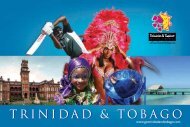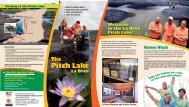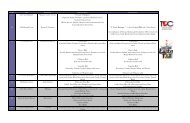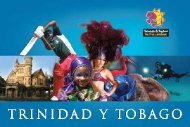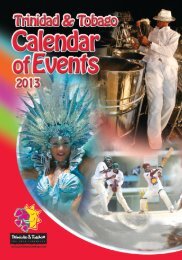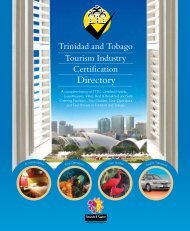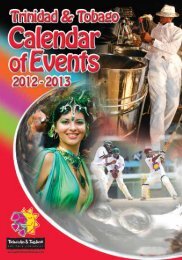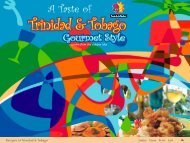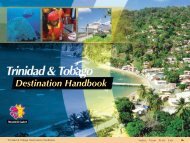Trinidad and Tobago - Destination Handbook
Trinidad and Tobago - Destination Handbook
Trinidad and Tobago - Destination Handbook
You also want an ePaper? Increase the reach of your titles
YUMPU automatically turns print PDFs into web optimized ePapers that Google loves.
\ Index View Print Exit /<br />
Want to get a true sense of what it’s like to live here<br />
Visit some our towns <strong>and</strong> cities…explore the wonders they have to offer!<br />
ARIMA<br />
Many of the names of towns <strong>and</strong> villages that<br />
you see on a map of <strong>Trinidad</strong> <strong>and</strong> <strong>Tobago</strong> can<br />
be attributed to the Amerindians that were<br />
indigenous to our isles. Arima, meaning ‘water’,<br />
is one such example. Founded by Capuchin monks<br />
in 1757, it is one of the earliest settlements on<br />
the isl<strong>and</strong>. Situated in the idyllic foothills of the<br />
Northern Range, it served as a meeting point for<br />
neighbouring estates <strong>and</strong> for the most part,<br />
led a quiet, sleepy life.<br />
Its calm reverie was broken in the 1780s, when<br />
the Mission of Arima as it was known, was used<br />
by Governor Jose Maria Chacon as a transfer point<br />
for all the Amerindians from the neighbouring<br />
districts, allowing distribution of the arable l<strong>and</strong> to<br />
newly arrived French planters under the Cedula.<br />
This continued until 1828 when Arima was no<br />
longer preserved as a Mission. By the 1870s,<br />
a radical transformation took place with the<br />
rapid spread of the cocoa industry. Planters<br />
began to clamour for a more efficient system<br />
of transportation into Port of Spain. Arima,<br />
historically the hub for the outlying districts saw<br />
the inauguration of the first railway line in <strong>Trinidad</strong><br />
for both passengers <strong>and</strong> freight.<br />
Today, the town of Arima has retained some of its<br />
original flavour as the hub via which people from<br />
the North <strong>and</strong> East coasts traverse in order to do<br />
their shopping or travel into the capital. Arima’s<br />
economy has changed from an agricultural base<br />
to an industrial one, with the establishment of<br />
factories <strong>and</strong> housing estates along the outskirts<br />
of town. The area still remains home to much of<br />
the Amerindian population, though you would be<br />
hard pressed to find anyone of pure blood today.<br />
The feast of Santa Rosa, in which descendants<br />
of the Carib tribe parade in full regalia is still<br />
celebrated on the streets of the town, <strong>and</strong> on this<br />
special occasion a new Carib ‘Queen’ is selected.<br />
CHAGUANAS<br />
The Borough of Chaguanas, located in Central<br />
<strong>Trinidad</strong> is one of our oldest known settlements,<br />
pre-dating the Spanish colonists. The story goes<br />
that it was named after the indigenous tribe that<br />
lived in the area at the time, the Chaguanes.<br />
Historically, Chaguanas was ignored by the<br />
Spanish <strong>and</strong> only came into prominent use after<br />
the isl<strong>and</strong> became a British colony. The area was<br />
considered to be excellent for the cultivation of<br />
sugar cane <strong>and</strong> as a result, several large estates,<br />
<strong>Trinidad</strong> & <strong>Tobago</strong> <strong>Destination</strong> H<strong>and</strong>book<br />
24




